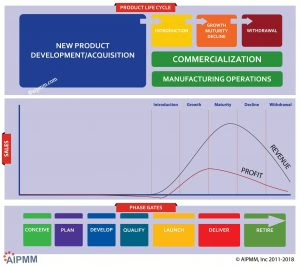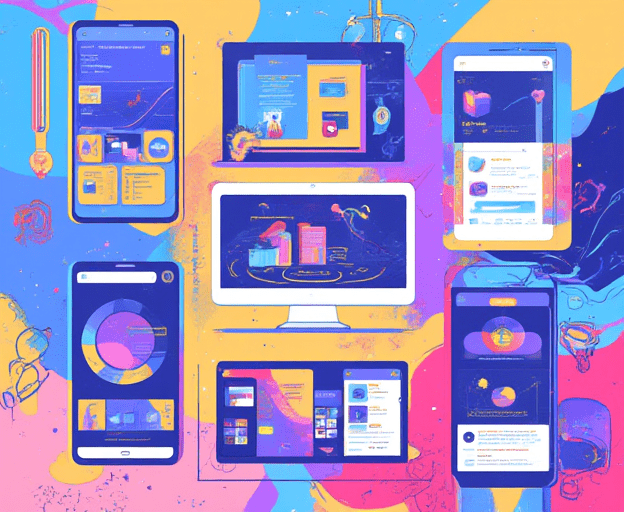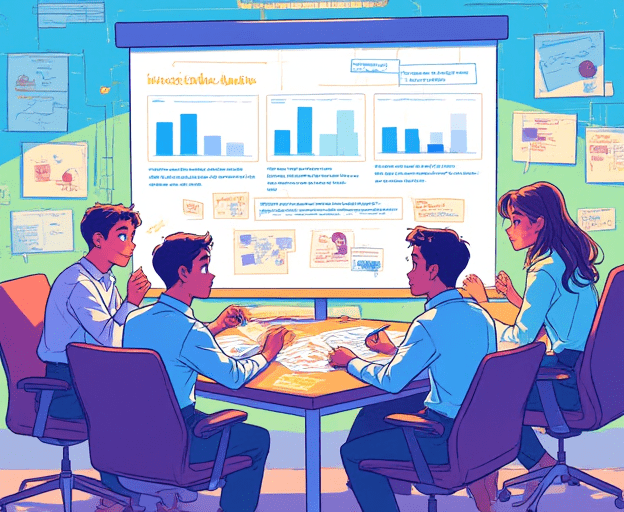Product Life Cycle

AIPMM Product Life Cycle Framework
The success of a product is characterized by key activities in each phase of the product life cycle. When the product team aligns with this clear plan of activities, they complete their objectives and can better support products wherever they are in the life cycle. As a result, this can produce a multitude of benefits including increased profitability and greater sustainability for the company.
Know what you need to know in each phase.
You can plan for events throughout the product life cycle by following the seven, distinct product life cycle phases. Every product, whether a good or a service will pass through these predictable phases, each in their own time. The seven phases of the product life cycle include: conceive, plan, develop, qualify, launch, deliver, and retire. By keeping your eye on key activities needed in each phase you can minimize both the risk of product failure and your time to market. Additionally, understanding the big picture of how these phases fit together and occasionally overlap, will hone your skills in developing future product roadmaps even if your product is stuck in a single phase today.
Phase 1: Conceive
Before initiating product development, first, examine the market. This preliminary stage calls for a great deal of market research. You can start your market research by analyzing the trends in the industry. Porter’s Five Forces Analysis is a great tool that can assist you as you review the industry environment. As a quick refresher, Porter’s Five Forces Analysis is made up of 1) industry rivalry, 2) threat of substitutes, 3) bargaining power of buyers, 4) bargaining power of suppliers, and 5) barriers to entry (Porter, 1988).
Additionally, you’ll want to watch for shifts and improvements in industry technology. Advances made in this area can usually impact your product even if outside the tech industry. Technological advances can change how your product is manufactured, sold, or used by your customers. Another great tool to view the environment surrounding your product is the PEST analysis. This tool encompasses an examination of current political, economic, socio-cultural, and technological factors.
Avoid chasing trends for the sake of pursuing them.
It might sound obvious, but it is likely that the team is so close to the industry or the trend, that they miss this point.
Now that you are aware of current trends, it is time to take note of opportunities. Another excellent tool is the SWOT analysis. This tool involves reviewing your company’s strengths, weaknesses, opportunities, and threats. Once you have analyzed your opportunities, shift your focus specifically to opportunities that provide solutions that your customers need. Don’t get trapped into focusing only on the features that you and your team like—focus on the needs of your customers. Remember the customers will decide if the product is a success, it’s ultimately their decision to buy or not.
Developing the right product at the right time is crucial to success.
Overall, the extent of this market research is dependent on your organization’s resources and priority. This process can range from simple surveys to extensive ethnographic research.
Once you’ve finished the preliminary stage of research, you should have a grasp on the kind of product you need to create during the conceive stage. However, it’s essential to continue to brainstorm to generate a few more ideas. Then, prioritize the best ones and then make your decision.
Phase 2: Plan
During this stage of the product life cycle, the team zeros in on the purpose of the product. Does your product’s purpose and solution align with your target market’s needs?
However, if your answer to the value question begins or ends with “I think this matches the need,” you want to go back to the drawing board. Refocus on the needs your target audience until you are certain this is the best solution. By thoughtfully answering this question you can improve your likelihood of profitability and long-term success.
Once you have your answer, it’s time to develop your strategy, business case, and product description. While you produce those three items keep in mind your market research, the market needs, and your competitive analysis. Fortune 500 companies are asking themselves these questions for their competitive analysis.
Laying out the product roadmap is the final part of this process. There are two types of product roadmaps, internal and external. There are eight steps to building a product roadmap. These are as follows:
- Decide on the detail level
- Assess competitors and trends
- Prioritize requirements
- Designate a time frame
- Select an organization strategy
- Create an internal roadmap
- Collect buy-in and finalize
- Develop an external roadmap
It’s often during this phase that the entire premise of the product changes. The initial product development lays out an intention— but the actual purpose reveals itself once logistics and resources are considered and applied.
The more open your organization is to adjusting and fine-tuning the original concept, the more successful the product will be.
Before closing this phase, ensure your product is on the right track. You can use several different exercises to test this, but the best one is the Minimum Viable Product test.
Phase 3: Develop
Once you have completed outlining your product’s purpose, it’s time to move into the development phase. The main priority now is scheduling. Having deadlines in place is essential for your engineering and sales team. It informs your engineers of when you expect releases. It also notifies sales and allows them to relay information about order time to customers accurately. Your timeframes could be as frequent as quarterly; they could be yearly, or a combination of both.
The timeframe you choose doesn’t matter. What does matter, is that you and your team are on the same page for deadlines.
The next step is to choose a strategy to organize your releases. There are three types of plans for organizing your releases. These are the organization by themes, the golden feature, or by the timed releases. The strategy you select depends on your end goals, budget constraints, and product. We’ll cover each one briefly below.
A theme-based organization strategy requires you to collect and group similar, high-scoring features. Every grouping receives a theme and a deadline for release. For instance, a theme could be product performance with features like screen refresh and retrieval time, UI responsiveness, and time to update the database. Implementation of themes helps protect against feature creep. You can use sub-themes; however, those tend to weaken the overall strategy.
The next strategy is the golden feature. This plan is relatively simple, select one primary feature for every release. All marketing and development resources need to focus on the golden feature. Applying this strategy also prevents against feature creep. However, no matter the circumstances, when you use this plan you cannot ship without the golden feature.
The final organizational strategy is the timed release. Unlike the plans before it, the timed release is driven by dates, not features. The average release dates are every quarter or six months. Prioritization is essential to meet deadlines. If the team missed a deadline, then they must refocus and work to achieve the release for the next one.
No matter what strategy you choose, be aware of the shifts and fluctuations in the market as you build. Your target audience will be changing all the time. Product flops are usually a result of refusals to adjust product plans.
Lose your focus on the market, and you lose your opportunity.
Phase 4: Qualify
This stage ensures your product is on the right track. There are three methods you can use to qualify your product. These are beta testing, focus groups, and internal feedback.
Beta testing requires frequent check-ins with your testers to gather feedback. Organize the critique given and develop actions to fix the product. Prioritize the revisions before adjusting to the product.
Another way to qualify is to host focus groups. It’s important to ensure that you’ve removed the three main potential distractions for your focus groups. The first is a physical distraction; this includes how you and/or the moderator dress and the demeanor in general. During these sessions, it’s important to be as physically neutral as possible, so you don’t influence the answers through your behavior. Distractions can also be biological. Scheduling long focus groups or scheduling just before meals can increase hunger fatigue and irritability in your participants which can skew the results. So think about offering a light snack to participants. Psychological distractions may be the most difficult to minimize. To remove them, you need to eliminate agenda-based or leading questions. This can be a bit tricky. For more in-depth information on working with focus groups.
The last way you can qualify your product is to reach out for feedback internally. Focus on questioning your sales and customer service teams. They often serve as the first point of contact between the company and the customer. They hear first-hand the problems that customer have with the product. Their insight also lets you know if your product is fulfilling the intended need.
Communicate the highlights of the information you gathered with your engineering team. Work with them on setting up additional deadlines for product bugs, and new features. Then, revise, repeat, revise, and repeat.
The quality of the final product reflects your effort.
Phase 5: Launch
You’ve made it to launch. The work from the stages before finally pays off. The launch includes the announcement to the market and also includes decisions around your product’s initial availability and exposure. With the market research you gathered earlier, you can create buyer profiles. Use information about how, where, and why your target segment buys to build the profiles. Six factors influence customer’s buying habits psychologically. These influencers are self-image, relationship with brands, memory and learning, emotional state, beliefs and attitudes, and communication. They all work together to influence how the customer perceives and interprets product launch announcements and messaging. The launch announcement needs this level of insight into the customer’s mindset.
Use the same insight into buying habits to make decisions around product availability. Where, when, and how can this product be purchased or acquired? At this point in the process, you should have a clear picture of the early adopters’ purchasing preferences to make these key selections.
Now, focus on growing product exposure. In this digital age, there are dozens of channels you can use to reach your customers, and your market research will have revealed those that are most effective for your particular target. Digital avenues are ideal for budgets that are limited. For further insights on increasing exposure when budgets and resources are tight, visit this webcast.
Efficiently leveraging digital opportunities maximizes your impact and minimizes your costs.
More traditional routes to increase exposure include television commercials, direct mail, and billboards. These channels typically require more capital and resources than their digital counterparts. However, if used for the right target segment, their effectiveness can be powerful.
Throughout this process, don’t make selling your primary goal. Focus on educating your market instead. Customers don’t purchase products because they have been commanded to do so. They have to want it. By sharing the value of your product and pairing it with a compelling story, you increase your chances of selling.
Phase 6: Deliver
The sixth phase of the product life cycle is delivery. Your product is on store shelves, in people’s homes, and in workplaces. However, this isn’t the end of the product life cycle. Delivery involves maintenance of current programs, frequent measurements of ROI, and product optimization.
Product optimization is often glossed over as the business shifts resources to work on the next big product. Despite the possible change of company focus, your job as a product manager is to ensure your product stays in top condition. Continue to invest in improvements for your best performing-products on a regular basis. This maintenance strengthens your value proposition over time.
Gather insights on how you can optimize by setting up channels or methods to collect feedback from customers. This information can shed light on features your product lacks or bugs that need fixing. Share this information with your engineering team and develop additional deadlines to implement changes. Clear communication with the engineering is critical for product improvement.
Listen to the customer–your product’s long-term success depends on it.
As time goes by, your target market’s environment and needs change. Frequently evaluate your product’s proposition to stay ahead of the competition. Ensure that the value proposition stays clear and compelling for customers. A strong value statement can lead to dramatic increases in sales.
Your value proposition gets your product off the shelves and into carts.
Phase 7: Retire
The seventh and final step in the product life cycle is retirement. Retiring your worst performers can save your business from products that could drain valuable resources and potentially damage future growth. During this phase, it’s important to aim for a successful product retirement with the least amount of fallout or negative consequences.
The first step is to learn more about the failing product. Why did it struggle to perform? Was there a lack of planning? Did it fail to meet a need initially? Did customers lose interest in it? Once you’ve uncovered the answers, they can inform how you move onto the most critical part of retirement, transitioning.
There are two steps to transitioning your customers to another product. First, you need to communicate the move to customers using strategic messaging. The message about the retiring product needs to be clear and should build excitement around the new product. Then, the funnel or path to make the transition to the new product must be easy to navigate for the customer.
Lastly, ensure you have educated your customer service team and sales team on the changes. They need to know the ins and outs of the new product, so they are best equipped to assist customers and their questions. It’s also crucial that you have enough customer support members on standby to handle the influx of inquiries or help customers with the transition.
Remember, big ideas are only as great as the process you have to implement them.
Wrapping up
Having a big picture understanding of the critical activities in each of the seven phases of the life cycle can benefit you, your team and your product even if the product is stuck in just one phase. It won’t be there forever and neither will you.

